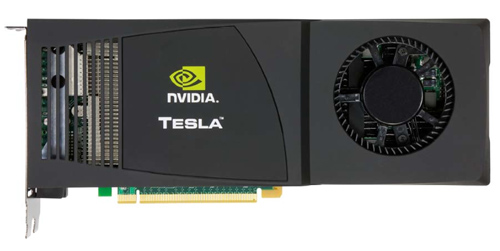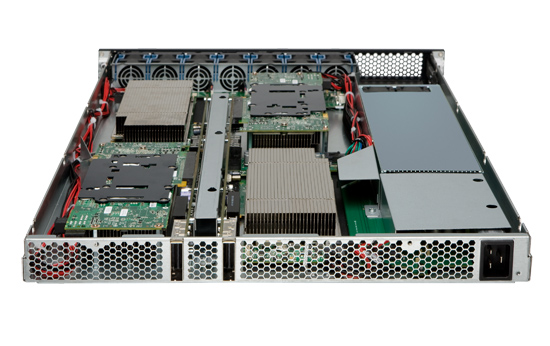NVIDIA's Fermi: Architected for Tesla, 3 Billion Transistors in 2010
by Anand Lal Shimpi on September 30, 2009 12:00 AM EST- Posted in
- GPUs
A Different Sort of Launch
Fermi will support DirectX 11 and NVIDIA believes it'll be faster than the Radeon HD 5870 in 3D games. With 3 billion transistors, it had better be. But that's the extent of what NVIDIA is willing to talk about with regards to Fermi as a gaming GPU. Sorry folks, today's launch is targeted entirely at Tesla.

A GeForce GTX 280 with 4GB of memory is the foundation for the Tesla C1060 cards
Tesla is NVIDIA's High Performance Computing (HPC) business. NVIDIA takes its consumer GPUs, equips them with a ton of memory, and sells them in personal or datacenter supercomputers called Tesla supercomputers or computing clusters. If you have an application that can run well on a GPU, the upside is tremendous.

Four of those C1060 cards in a 1U chassis make the Tesla S1070. PCIe connects the S1070 to the host server.
NVIDIA loves to cite examples of where algorithms ported to GPUs work so much better than CPUs. One such example is a seismic processing application that HESS found ran very well on NVIDIA GPUs. It migrated a cluster of 2000 servers to 32 Tesla S1070s, bringing total costs down from $8M to $400K, and total power from 1200kW down to 45kW.
| HESS Seismic Processing Example | Tesla | CPU |
| Performance | 1 | 1 |
| # of Machines | 32 Tesla S1070s | 2000 x86 servers |
| Total Cost | ~$400K | ~$8M |
| Total Power | 45kW | 1200kW |
Obviously this doesn't include the servers needed to drive the Teslas, but presumably that's not a significant cost. Either way the potential is there, it's just a matter of how many similar applications exist in the world.
According to NVIDIA, there are many more cases like this in the market. The table below shows what NVIDIA believes is the total available market in the next 18 months for these various HPC segments:
| Processor | Seismic | Supercomputing | Universities | Defence | Finance |
| GPU TAM | $300M | $200M | $150M | $250M | $230M |
These figures were calculated by looking at the algorithms used in each segment, the number of Hess-like Tesla installations that can be done, and the current budget for non-GPU based computing in those markets. If NVIDIA met its goals here, the Tesla business could be bigger than the GeForce one. There's just one problem:
As you'll soon see, many of the architectural features of Fermi are targeted specifically for Tesla markets. The same could be said about GT200, albeit to a lesser degree. Yet Tesla accounted for less than 1.3% of NVIDIA's total revenue last quarter.
Given these numbers it looks like NVIDIA is building GPUs for a world that doesn't exist. NVIDIA doesn't agree.
The Evolution of GPU Computing
When matched with the right algorithms and programming efforts, GPU computing can provide some real speedups. Much of Fermi's architecture is designed to improve performance in these HPC and other GPU compute applications.
Ever since G80, NVIDIA has been on this path to bring GPU computing to reality. I rarely get the opportunity to get a non-marketing answer out of NVIDIA, but in talking to Jonah Alben (VP of GPU Engineering) I had an unusually frank discussion.
From the outside, G80 looks to be a GPU architected for compute. Internally, NVIDIA viewed it as an opportunistic way to enable more general purpose computing on its GPUs. The transition to a unified shader architecture gave NVIDIA the chance to, relatively easily, turn G80 into more than just a GPU. NVIDIA viewed GPU computing as a future strength for the company, so G80 led a dual life. Awesome graphics chip by day, the foundation for CUDA by night.
Remember that G80 was hashed out back in 2002 - 2003. NVIDIA had some ideas of where it wanted to take GPU computing, but it wasn't until G80 hit that customers started providing feedback that ultimately shaped the way GT200 and Fermi turned out.
One key example was support for double precision floating point. The feature wasn't added until GT200 and even then, it was only added based on computing customer feedback from G80. Fermi kicks double precision performance up another notch as it now executes FP64 ops at half of its FP32 rate (more on this later).
While G80 and GT200 were still primarily graphics chips, NVIDIA views Fermi as a processor that makes compute just as serious as graphics. NVIDIA believes it's on a different course, at least for the short term, than AMD. And you'll see this in many of the architectural features of Fermi.










415 Comments
View All Comments
yacoub - Thursday, October 1, 2009 - link
uh-oh, boys, he's foaming at the mouth. time to put him down.SiliconDoc - Thursday, October 1, 2009 - link
Ah, another coward defeated. No surprise.yacoub - Wednesday, September 30, 2009 - link
"The motivation behind AMD's "sweet spot" strategy wasn't just die size, it was price."LOL, no it wasn't. Not when everyone, even Anandtech staff, anticipated the pricing for the two Cypress chips to be closer to $199 and $259, not the $299 and $399 they MSRP'd at.
This return to high GPU prices is disheartening, particularly in this economy. We had better prices for cutting edge GPUs two years ago at the peak of the economic bubble. Today in the midst of the burst, they're coming out with high-priced chips again. But that's okay, they'll have to come down when they don't get enough sales.
SiliconDoc - Thursday, October 1, 2009 - link
It was fun for half a year as the red fans were strung along with the pricing fantasy here.Now of course, well the bitter disappointment, not as fast as expected and much more costly. "low yields" - you know, that problem that makles ati "smaller dies" price like "big green monsters" (that have good yields on the GT300).
--
But, no "nothing is wrong, this is great!" Anyone not agreeing is "a problem". A paid agent, too, of that evil money bloated you know who.
the zorro - Thursday, October 1, 2009 - link
silicon duck, please take a valium i'm worried about you.SiliconDoc - Thursday, October 1, 2009 - link
Another lie, no worry, you're no physician, but I am SiliconDoc, so grab your gallon red water bottle reserve for your overheating ati card and bend over and self administer you enema, as usual.araczynski - Wednesday, September 30, 2009 - link
sounds like ati will win the bang for the buck war this time as well. at least it makes the choice easier for me.marc1000 - Wednesday, September 30, 2009 - link
Some time ago I heard that the nex gen of consoles would run DX11 (Playstation2 and Xbox were DX7, PS3 and X360 DX9. So PS4 and X720 could perfectly be DX11). If this is the case, we are about to see new consoles with really awesome graphics - and then the GPU race would need to start over to more and more performance.Do you guys have any news on those new consoles development? It could complete the figure in the new GPU articles this year.
Penti - Friday, October 2, 2009 - link
I think you mean DX9 class hardware, PS3 who has zero DX9 support and XBOX360 has DX9c class support but a console specific version. PS3 was using OpenGL ES 1.0 with shaders and other feature from 2.0 as it was release pre OpenGL ES 2.0 spec. The game engines don't need the DX API. It doesn't matter to game content developers any way.Xbox was actually DirectX 8.1 equivalent. As said next gen consoles are years away. Larrabee and fermi will have been long out by then.
haukionkannel - Thursday, October 1, 2009 - link
Rumours says that next generation consoles are releaset around 2013-2014...But who can say...